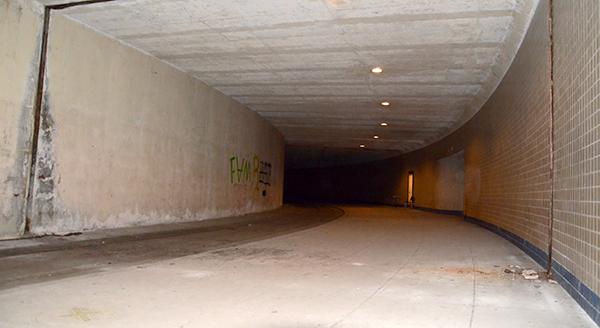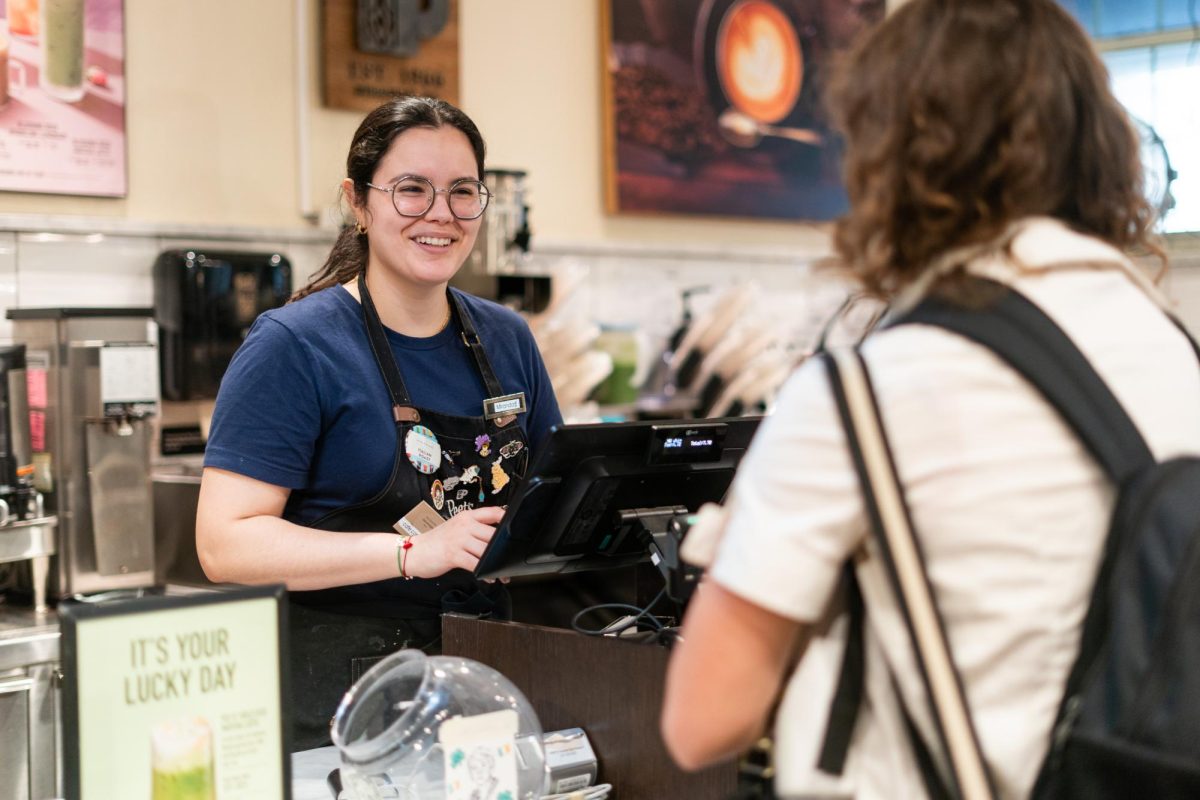Updated: Jan. 13, 2015 at 6:57 p.m.
It’s easy to mistake the raised, 5-by-10 concrete and metal slabs above ground in Dupont for ventilation sites or construction entrances.
They’re not. The nine concrete grates are entrances to staircases that lead down to 75,000 square feet of an abandoned trolley car station-turned-fallout-shelter-turned-food court below Dupont Circle that’s existed since the late 1940s but hasn’t been used since the 1990s.
In the next five years, about 23,000 square feet of that space will become a new kind of cultural and arts destination for the city.
At least, that’s the hope for Julian Hunt and Braulio Agnese, who are part of the Arts Coalition for the Dupont Underground, the nonprofit tapped by D.C. to renovate the space. By the time its five-year lease ends, the group expects to have full plans for developing the entire underground space, a project that could cost between $35 million and $70 million.
“Dupont is one of the great public spaces in the city, but it’s terribly neglected,” said Hunt, who co-founded the D.C.-based architecture firm Hunt Laudi Studio in 2001. “It’s the dirty nest syndrome – people have lived here so long they just don’t see it anymore.”
A changing landscape
It took about a decade for Hunt to convince the District to lease him the space for such a large-scale project, a feat made more difficult by its rarity – there’s no historical precedent in the city for an underground arts center, and it will be one of the first in the country. New York City opened its Fulton Center, an underground art gallery that showcases about 250 pieces, last fall.

“When Julian first started, they didn’t even want to admit the space existed, they just kind of wanted to forget about it,” Agnese said.
The pair attributed the holdup to different schools of thinking between U.S. and European architecture companies. Overseas, Hunt said, firms are more inclined to renovate existing historical sites, instead of increasing urban sprawl as U.S. companies are inclined to do.
“It’s a general cultural issue. Coming from a city like Barcelona, and from Europe in general, there’s a greater cultural investment in public life and public space. You’re kind of working against the current here anyway,” Hunt said. “The care of public space … is just not evident here, not built in the public consciousness. It’s something we want to bring into debate.”
In 2010, the city finally relented and opened a request for proposals to develop the space. By that point, Hunt had created the nonprofit arts coalition and he submitted an official proposal to the city that outlined his plans.
Only one other organization submitted a proposal, which Agnese dismissed as “not even real.”
“Underground spaces are compelling, but they’re a tough sell,” Agnese said.
Agnese, who was “in love with the project,” met Hunt at a fundraiser and regularly sent him emails asking to join the project. Hunt “finally said, ‘Yeah,’” Agnese said. That was five years ago, making him the longest active member of the project after Hunt.
It wasn’t until the end of last year that the firm officially obtained a five-and-a-half-year lease that signed over the entirety of the Dupont Underground to its care.
In that time, Agnese said the firm plans to make the space livable again, which includes adding running water, electricity, public restrooms and other amenities. Agnese said he hopes to have that accomplished by the end of this year.
“Every day not spent open is a day less on our lease,” Agnese said, adding that long-term plans for the buildout will take careful preparation. “Without real forethought and planning and understanding the space, it’ll probably fail.”
Designing the space
The underground is teeming with promise and possibilities.
Lined by white and blue tile on one side and concave pillars of cement on the other, the tunnels stretch for miles. They are completely empty, save for a stash of flashlights by the 19th Street entrance and a stack of plastic chairs in a tiny electric supply closet.
“Can’t you see a fashion show here?” Agnese said, gesturing down the tunnel with his flashlight beam. “It’s a blank slate. A concrete shell.”
A couple hundred feet down the tunnel, he stops and turns toward the concrete wall.
“I can just see a furniture company leasing this space for a photoshoot. Imagine a bright red sofa against this wall,” he said.
A former architecture magazine editor, Agnese understands how to make spaces look good.
The process of choosing which retailers to rent the space will be based on both vision and finances: While Agnese said they would like the underground space to become a cultural hub, he also realizes it’s not feasible for a nonprofit to single-handedly pull off a $70 million project.

“If we get a $100 million check from someone the whole project can be cultural, but the economics of that are very tough,” Agnese said. “We’re not getting any public money and we’re not going to assume we’ll get public money. We’d like that to change and hope the city does invest in us.”
Until then, they plan to lease the space to local retailers, which will open shop during the day to “make the economic model work,” until the night, when he hopes to host concerts, parties or special events. That’s all part of a plan to attract people at all hours of the day.
And while Agnese said they hope national retailers like Apple will set up shop underground, they also want to highlight local retailers and art galleries. Indeed, museums like The Phillips Collection and Hirshhorn Museum have already expressed interest in using the industrial space for potential exhibits.
Other options could include an underground WeWork studio, a center for urban agriculture or an amphitheater.
“World-class cities offer their citizens not just good services and the bureaucratic stuff, but they also pay attention to culture and the arts,” Agnese said. “The city is beginning to get there.”
He pointed to the 11th Street Bridge Park and Martin Luther King Jr. Memorial Library as examples of important architectural projects in D.C. that have garnered interest and donations from the city.
“Hopefully we can convince them they should invest in us,” Agnese said.
Drawing up a ‘credible plan’
In its first round of fundraising, Dupont Underground aims to raise $50,000 to help cover construction costs. Agnese said the team is still deciding whether to begin construction piecemeal using money as it comes in, or wait until they can renovate the entire space.
All of those construction plans, though, are in the short term.
Because the group will have to renegotiate the lease in about five years, there’s a chance that after hundreds of thousands of dollars in renovations, the lease may come to an end.
“It’s unknown. They’re favorably disposed toward us, but we have to come up with a credible plan,” Agnese said.
Long-term leases of public property require approval from the D.C. City Council, which will force the organization to resubmit a proposal once its five-year lease is up.
“The city is definitely changing in a positive way, and we think we’re just part of that,” Hunt said.
This post was updated to reflect the following corrections:
The Hatchet incorrectly reported that the Arts Coalition for the Dupont Underground was an architecture firm. It is a nonprofit organization. The Hatchet also incorrectly reported that Braulio Agnese was an architect. He is a former architecture magazine editor. Lastly, The Hatchet incorrectly reported that the renovations would cost millions of dollars over five years. Agnese expects that the renovations and cleanup will cost closer to hundreds of thousands of dollars. We regret these errors.






